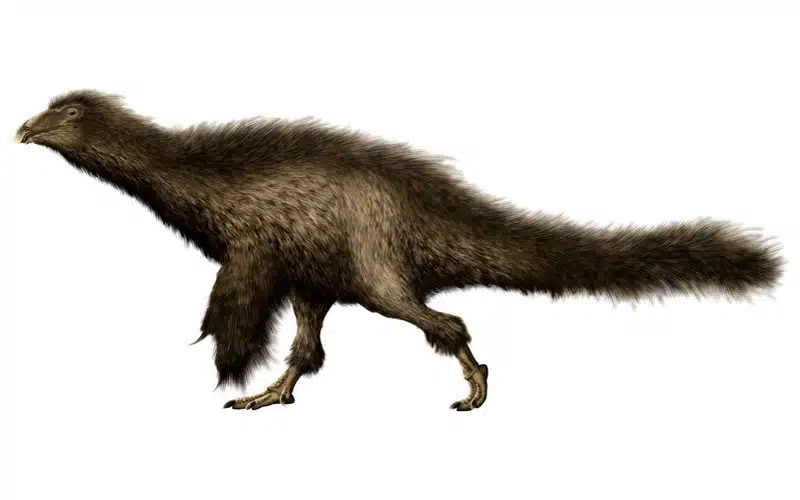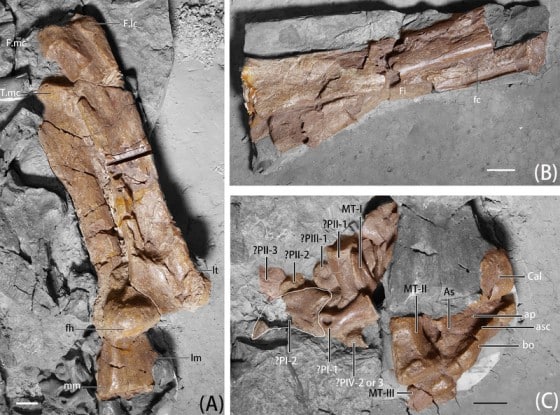Beipiaosaurus stands out as a fascinating subject of study. Not only for its unique place in the dinosaur lineage, but also for the intriguing insights it offers into the life of the Early Cretaceous Period. Discovered in the rich fossil beds of Liaoning, China, this Theropod defies the carnivorous nature typically associated with its group, presenting a herbivorous diet that piques curiosity and invites a closer look.
The discovery of Beipiaosaurus inexpectus near the city of Beipiao not only adds depth to our understanding of Therizinosauroid evolution but also challenges preconceived notions about the dietary habits and ecological roles of theropods. As we embark on this exploration, the aim is to shed light on the distinctive features and life of this ancient creature, drawing from the well of paleontological research to paint a comprehensive picture of its existence millions of years ago.
Beipiaosaurus Key Facts
| Keyword | Fact |
|---|---|
| Pronunciation | bay-pyow-SAWR-us |
| Meaning of name | Beipiao Lizard |
| Group | Theropod |
| Type Species | Beipiaosaurus inexpectus |
| Diet | Herbivore |
| When it Lived | 130.0 to 122.46 MYA |
| Period | Early Cretaceous |
| Epoch | Late/Upper Barremian to the top of the Early/Lower Aptian |
| Length | 7.2 feet |
| Height | Approximately 3.0 feet |
| Weight | 60.0 pounds |
| Mobility | Moved on two legs |
| First Discovery | 1996 by Li Yinxian |
| Described by | 1999 by Xu Xing, Tang Zhilu and Wang Xiaolin |
| Holotype | IVPP V11559 |
| Location of first find | Yixian Formation, Liaoning, China |
Beipiaosaurus Origins, Taxonomy and Timeline
The name Beipiaosaurus, translating to “Beipiao Lizard,” pays homage to its discovery site near Beipiao City and embeds the creature firmly within the rich tapestry of China’s paleontological history. This name combines Chinese and Greek roots and acts as a bridge between Eastern and Western science.

Belonging to the Therizinosauroid family, our subject represents a fascinating branch of the Theropod group–known predominantly for their fearsome carnivorous members. Yet it defies expectations with its herbivorous diet, placing it in a unique evolutionary position. The type species, Beipiaosaurus inexpectus, stands as a testament to the unexpected nature of this discovery. With no subspecies currently identified, it highlights its individuality in the fossil record.
Spanning the Late Barremian to Early Aptian Stages of the Early Cretaceous Period, the timeline of this dino stretches from approximately 130.0 to 122.46 million years ago. This era was rich in geological and biological transitions and provided a captivating backdrop to the life and times of Beipiaosaurus, who offers insights into a world undergoing profound changes.
Listen to Pronunciation
Discovery and Fossil Evidence
This journey began in 1996 when Li Yinxian, a local farmer, found the remains of a Theropod dinosaur near Sihetun village. This find was later confirmed to originate from the Yixian Formation’s lower beds, which date back to the Aptian Stage of the Early Cretaceous Period. On May 27, 1999, the journal Nature announced the naming of Beipiaosaurus inexpectus by Xu Xing, Tang Zhilu and Wang Xiaolin. The name, meaning “Beipiao Lizard,” reflects the location of its discovery, while “inexpectus” remarks on the dinosaur’s unexpected features.

Jaime A. Headden, CC BY 3.0, via Wikimedia Commons
The holotype, IVPP V11559, was found in the Jianshangou Beds of the Yixian Formation. This partial, disarticulated skeleton of a sub-adult dinosaur included crucial elements like parts of the skull, spine, limbs, and even impressions of primitive plumage that provide a rare insight into its appearance and biology. A second specimen, STM 31-1, described in 2009, and a third, BMNHC PH000911, demonstrated unique, elongated feathers and well-preserved skeletal elements. These finds collectively enhance our understanding of this herbivorous dinosaur’s anatomy, lifestyle, and evolutionary significance through the collaborative efforts of scientists and local discoverers.
Beipiaosaurus Size and Description
Therizinosaurs are a group known for their often large size and distinctive long necks. Unlike its more advanced relatives, such as Segnosaurus or Therizinosaurus, Beipiaosaurus showcased a more modest stature and shorter neck. This feature suggests a different ecological niche or feeding strategy. The dinosaur’s feet also differed from the typical Therizinosaurid configuration; instead of four toes, it retained a more primitive three-toed arrangement, hinting at its evolutionary position as a bridge between earlier Theropods and the more specialized Therizinosaurs.
Size and Weight of Type Species

Beipiaosaurus measured approximately 7.2 feet in length, making it one of the smaller members of its family. This size is particularly notable because, before the discovery of Yutyrannus, Beipiaosaurus was the largest dinosaur known to have feathers. The estimated weight of Beipiaosaurus is around 60.0 pounds based on the length of its femur. This relatively light weight combined with its feathered body suggests a creature adapted to a specific ecological niche, possibly involving agility and thermoregulation.
The Dinosaur in Detail
Beipiaosaurus showcased a large head for its family. Its lower jaw was as long as its femur and its neck was shorter than those of its Therizinosaur cousins. This proportion suggests a robust build with a head designed for a specific diet or feeding behavior not typically seen in other members of its group. The 2003 discovery of a pygostyle–the fused vertebrae at the tail’s end–added another layer to our understanding. Unlike in modern birds, where the pygostyle supports tail feathers for flight, this pygostyle suggests early experimentation in tail structure and feathering without a direct link to flight capabilities. The tail had feathers up to 2.8 inches long composed of parallel filaments, a characteristic not associated with the feathers or tail fans seen in modern birds.
The holotype specimen revealed short, slender filamentous feathers on the left arm. These downy fibers were longer and oriented perpendicular to the arm. They suggest a body covered predominantly in a primitive type of feather; similar yet more advanced than those found on Sinosauropteryx. This feathering indicates an intermediate evolutionary stage between the simple filaments of early feathered dinosaurs and the complex feathers of later avians.
Unlike most modern feathers we are used to seeing, Beipiaosaurus had a specific primitive type of feather that was made of single, unbranched strands. Because the feather impressions in multiple specimens were unbent, it is assumed that these feathers would have been relatively stiff. These unique feathers measured about 4 to 6 inches long and up to 0.12 inches wide. This distinctive feathering not only highlights Beipiaosaurus’s place in the evolutionary narrative of feather development but also suggests a variety of functions, from thermoregulation to display, that influenced the survival and social interactions of this intriguing dinosaur.
Interesting Points about Beipiaosaurus
- It is one of the earliest known Therizinosauroids. This group is distinguished by their unusual blend of herbivorous habits within a predominantly carnivorous lineage.
- The discovery of feather-like structures provides compelling evidence for the presence of primitive feathers in non-avian theropods. Furthermore contributing to the debate on the evolution of feathers.
- Its discovery within the Yixian Formation places it at the heart of one of the most significant paleontological sites for understanding the Jurassic-Cretaceous transition.
- Despite being a Theropod, its physical adaptations for an herbivorous lifestyle underscore the evolutionary flexibility and ecological diversity of dinosaurs.
Beipiaosaurus in its Natural Habitat
The climate was temperate to subtropical and supported a rich tapestry of vegetation surrounded by abundant water sources. However, this environment was marked by seasonal volcanic activity, a dynamic setting for Beipiaosaurus and its contemporaries. This environment required constant adaptation and adjustment. This perhaps explains the rapid changes and wide diversity of life in the area.
In terms of diet, its herbivorous nature meant it likely fed on a variety of plants in these forests. It used its beak and possibly its cheek-like structures to strip leaves and perhaps even fruits or seeds. Its bipedal locomotion suggests a lifestyle that could have included foraging from forest floors to reaching up into lower branches. The social behavior of Beipiaosaurus remains a topic of speculation, with possibilities ranging from solitary living to forming small groups. This may have been influenced by seasonal food availability or reproductive behaviors.
Contemporary Dinosaurs
In the shadow of ancient conifers, Beipiaosaurus tread softly among Asian dinosaurs, its feathers bristling at the slightest sound. This dino was neither the largest nor the smallest of its time. Among its contemporaries, Suzhousaurus loomed larger. This behemoth could easily intimidate Beipiaosaurus through sheer size alone. It’s likely that their paths crossed less in conflict and more in a mutual respect for territory. Indeed, Suzhousaurus might have preferred different dining options. This allowed Beipiaosaurus to forage alongside its cousin in peace among the lower shrubs for its plant-based diet.
However, peace was not always a guarantee–especially with Shanag lurking in the underbrush. Smaller but more agile, Shanag could have posed a significant threat to especially the young or the sick Beipiaosaurus. This predator-prey dynamic meant Beipiaosaurus needed to rely on its agility to escape the swift legs of Shanag. The dense forests they inhabited provided both cover and peril and set the stage for a high-stakes game of hide and seek. There, only the most alert could hope to survive.
Amidst these tense interactions, Beipiaosaurus also shared its world with Psittacosaurus and Archaeoceratops. Two dinosaurs that were roughly the same size and possibly competed for similar resources. These encounters could have ranged from peaceful coexistence to direct competition for the most nutritious plants. The beak of Psittacosaurus was well-equipped to snatch up the most succulent leaves, potentially leaving Beipiaosaurus to scavenge for leftovers. Archaeoceratops, similar in diet and a bit smaller, might have favored different feeding grounds to these contemporaries.
Frequently Asked Questions
It was an herbivore that fed on a variety of plants available during the Early Cretaceous Period.
It moved on two legs–a bipedal locomotion that allowed it to navigate its environment with agility.
The first fossils were found in the Yixian Formation, Liaoning, China. This site is renowned for its contribution to paleontology.
Its herbivorous diet and the presence of primitive feathers distinguish it from the typically carnivorous Theropods.
They date back to the Early Cretaceous Period, approximately 130.0 to 122.46 million years ago.
Sources
The information in this article is based on various sources, drawing on scientific research, fossil evidence, and expert analysis. The aim is to provide a comprehensive and accurate overview of Beipiaosaurus. However, please be aware that our understanding of dinosaurs and their world is constantly evolving as new discoveries are made.
- https://www.nature.com/articles/20670#:~:text=Beipiaosaurus%20is%20the%20largest%20known,its%20dentary%20is%20down%2Dturned.
- https://www.researchgate.net/publication/227941209_Pygostyle-like_Structure_from_Beipiaosaurus_Theropoda_Therizinosauroidea_from_the_Lower_Cretaceous_Yixian_Formation_of_Liaoning_China
- https://www.ncbi.nlm.nih.gov/pmc/articles/PMC2630069/
- https://www.researchgate.net/publication/332368922_Cranial_osteology_of_Beipiaosaurus_inexpectus_Theropoda_Therizinosauria
Article last fact checked: Joey Arboleda, 02-14-2024









